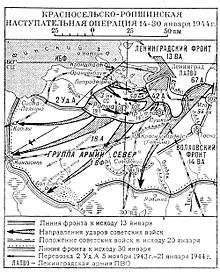Oranienbaum bridgehead
In Oranienbaum Bridgehead (sometimes boiler of Orange Tree called) were during the Soviet German war from 1941 to 1944 troops of the Red Army of the Armed Forces in an area on the Gulf of Finland to the northern Russian city Oranienbaum (now Lomonosov ), west of Leningrad , locked in. It is not to be confused with the "Oranienbaum bridgehead" in 1945 in the German city of Oranienbaum .
history
On September 16, 1941, German troops of Army Group North ( 1st Panzer Division , 58th and 254th Infantry Division ) arriving from the south near Peterhof reached the Gulf of Finland and cut off parts of the Soviet Leningrad Front (including the 8th Army ) their main power to Leningrad. A short time later, the German associations also included Leningrad and the Leningrad blockade began.
The bridgehead measured 60 km in an east-west direction and 25 km in a north-south direction. It was supplied from the island of Kotlin, also held by Soviet troops, with Kronstadt in the north and from Leningrad. The center of the bridgehead was Fort Krasnaya Gorka , a large-scale fortification from the First World War that belonged to the former sea fortress of Emperor Peter the Great . Oranienbaum received artillery support from Kronstadt and from the ships of the Baltic Fleet , which from August 30th deployed the battleships Oktjabrskaja Revoljuzija and Marat in this area , as well as the cruiser Kirov , the Flotilla Leader Minsk , the destroyers Surowy , Gordy , Smetliwy and Slawny and a few others Ships. The bridgehead positions, together with the Kronstadt fortress, protected Leningrad from German attacks from the sea. The supply was only possible via the Gulf of Finland.
The balance of power in autumn 1941 is given as follows: the Soviet troops comprised five rifle divisions and two brigades of marine infantry, the German XXVI. Army Corps blocked the bridgehead with four infantry divisions (from west to east: 217th , 254th , 93rd and 212th ).
In 1942 the Wehrmacht planned an attack on the Kessel ("Operation Bettelstab" or Operation Northern Lights ), but a Soviet attack and the First Ladoga Battle prevented implementation.
Beginning in November 1943, the troops in the bridgehead were secretly reinforced by parts of the Soviet 2nd Shock Army with about 44,000 men, 600 artillery pieces and other material. On January 14, 1944, it broke out of the bridgehead as part of the " Krasnoye Selo - Ropscha Operation" (part of the Leningrad-Novgorod Operation ), supported by the artillery from Kronstadt and ships of the Baltic Fleet. The German Wehrmacht was thrown back and the Leningrad blockade was broken. The Soviet troops advanced far south and west.
literature
- Werner Conze: The history of the 291st Infantry Division 1940–1945 , Podzun Verlag, 1953.
- F. Ziemke and E. Bauer Magna: Moscow to Stalingrad. Decision in the East , Center of Military History, Washington 1987.

